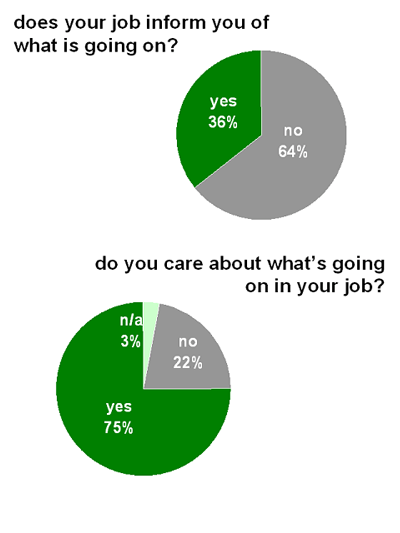marketing
 |
"…rather than communicate first, ask questions later, try it the other way around" - Al Berrios, Managing Director, al berrios & co.
Have you ever stopped to read a two-line corporate memo that has just enough information to make you curious, but not enough for you to actually care about asking? Have you ever skimmed for the word "layoff" through the 5-page email sent by the CEO, then deleted it because it has nothing else to do with you? In a recent employee sentiment study of randomly selected employees released by al berrios & co. last month, when asked if their employer informs them of what's going on at the company, 64% said no vs. 36% who said yes. When it comes to the company you work for, you do care about what's going (75% of respondents said they do), but only as far as it relates directly to you. And here's the problem with internal communications today.
Heralded as one of the best investments a company can make to motivate employees and increase workforce productivity, few companies do it right. Communicating corporate strategy is difficult, there's no argument there, but why would your company's entry into China be relevant to you? A CEO is wasting time fighting natural resistance to change, when he should spend more time aligning his ideas with employee goals: "As we move into China to sell our products to their 1.3 billion consumers, your current jobs won't change, plus there will be new job opportunities (both promotions and lateral shifts) for current employees who want to travel, learn new things, and meet new people on our dime." When John Smith, former CEO of GM, asked his consultants whether or not his subordinates understood GM's strategy for battling imports, his consultants had the unfortunate luck of informing him that out of 64 interviewed, 63 didn't think the company had a strategy (with the last one being John Smith himself). Since CEOs (and often, their subordinates) weren't trained to write effective copy, you can't blame them for poor internal communications. But it doesn't end here.
CEOs have a challenge with transparency. Not only to prevent their strategy from getting in to the hands of the competition; but often times, they really don't know which execution makes the best sense to reach their goals. From peer-pressure-lead mergers to returning cash to shareholders, margin for error is unfortunately not too wide. In lieu of all their options, how should a CEO align his entire organization along his vision?
You can start by understanding your workforce better. Krispy Kreme Doughnuts is a prime example: they dedicate enormous amounts of energy to allowing their workers to express themselves through story telling. It's worked out so well that without any marketing, they've become a cult brand, in no small part due to the engagement of their front-line worker with customers.
Believe it or not, many in your organization work for a paycheck. Worse still, even if you made an attempt to convince them individually, they're likely too close-minded to see the big picture that you see. So why bother? For the same reason you bother trying to get just one customer to believe in your vision. The customer isn't really interested in your strategy as long as you give them what they want, when they want it. Consequently, rather than communicate first, ask questions later, try it the other way around. Getting insight on your workers is one of the most powerful first-starts to selling your vision to your employees.
Second, now that you have the insight, don't assume anything. Our research reveals that contrary to what you may think, employees value their job description, professional development opportunities, and great working environment as much as they value their pay and benefits. This means that "labor arbitrage", as outsourcing experts refer to it, isn't simply a matter of managing your highest cost. Remember that saying, "Do unto others…". Not surprisingly, your workers also value reliable management among their top 5 feelings about their current job.
Third, execute a new organizational model and overcommunicate the hell out of it, but do it all without the complexity. The simpler it is, the faster it'll get digested by an individual employee the way you wanted it to. When Humana, a $12 billion Midwest health benefits provider, surveyed its employees on their perceptions of the firm, many came back with unexciting perceptions, but recognized Humana was trying to change. This lead Humana to dramatically modify the way they do business, making it simpler for everyone to understand, and ultimately leading to a quintupling of their stock since 2001.
Remember, any misperceptions can harm your plan (just like the recent rumors of a draft being instituted upon Bush's reelection harmed Bush's perception by young voters.) By changing your org model, you're more cost effectively going to change the way your organization behaves, so at the end of the day, you'll have a more informed and involved organization.
Write to Al Berrios
at editor@alberrios.com
Related
alberrios.com Sections
- HR Management Analyses + Recommendations
Top
Related Content
- "ALLIED DOMECQ PLC's Annual Report"
Disclaimer:
The recommendations, commentary and opinions published herein are based on
public information sometimes referenced via hyperlinks. Any similarities or
likeness to any ideas or commentary from any other sources not referenced
is purely coincidental. al berrios & co. cannot control any results occurring
from advice obtained from this publication nor any opinion(s) conveyed by
any reader of this publication.
(c) 2004. All Rights Reserved. al berrios & company, inc. Published
by al berrios & co. This Report may not be reproduced or redistributed
in any form without written permission from al berrios & co., subject
to penalty.